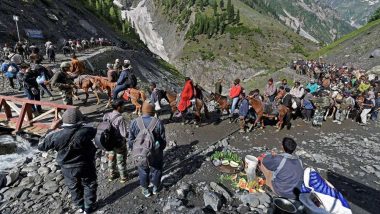Srinagar, June 26: The annual yatra to the holy cave shrine of Amarnath in south Kashmir Himalayas will begin on July 1, 2019 and will conclude on August 15, 2019. The pilgrimage to the shrine will commence from the twin routes of Baltal in Ganderbal and Pahalgam in Anantnag districts on July 1. With just a few days left, security arrangements for the forthcoming annual Amarnath Yatra have scaled up. Authorities have decided to issue a barcode-enabled authority slip to pilgrims to keep a track of the actual number of people travelling to and from the cave shrine. Amarnath Yatra 2019: DIG North Kashmir, SSP Bandipora Take Stock of Arrangements.
The annual yatra to the 3,880-metre high Amarnath shrine is scheduled to begin from the traditional Pahalgam track in Anantnag district and shorter Baltal track in Ganderbal district. In 2019, the 46-day-long yatra will begin on July 1, the day of Masik Shivratri, and would conclude on August 15, the day of Shravan Purnima. According to reports, over 1.10 lakh pilgrims have registered for the annual Yatra. Jammu & Kashmir Assembly Elections 2019: Poll Dates & Schedule to be Released After Amarnath Yatra, Says EC.
Amarnath Yatra Route
Pilgrims planning to visit Amarnath can take one of the two routes- the Pahalgam route and the Baltal to Amarnath Cave route. If pilgrims take the Pahalgam route (46km), devotees need five days to reach the cave.
If pilgrims take the Baltal to Amarnath Cave route (14 km), they can reach within one day on foot. Although risky, this route is the most popular among pilgrims who also use ponies to travel along this course.
Closest Airport
The closest airport to reach the holy shrine in Amarnath is Srinagar. The Srinagar airport is located at a distance of around 95 km from Pahalgam, the base camp for Amarnath Yatra.
Weather Conditions
The Holy Cave is situated at an altitude of 13,500 feet above sea level atop South Kashmir Himalayas. So pilgrims have to be wary of health problems at such high altitudes. The temperature may anytime fall to below five degrees Celsius. The oxygen level in the air is very low due to which many yatris face respiratory and other related medical problems. The high-altitude trek to the Holy Cave involves exposure to extreme cold, low humidity, increased ultraviolet radiations and reduced air pressure.
Security Arrangements
According to reports, four yatris were killed in a landslide on the Baltal route during this year's pilgrimage. There will be access control checking gadgets that will be deployed both at the Pahalgam and Baltal routes. The barcode will capture all the information of a pilgrim and it can be accessed by a click of the mouse. Tight security arrangements put in place to protect the pilgrims this year to minimise accidents.
Helicopter Bookings
The online booking for helicopter tickets for the annual yatra can be done at the official website of the Shrine Board- shriamarnathjishrine.com. Heli services are also being provided by private operators on both the routes to Holy Cave at the rates approved by Shri Amarnathji Shrine Board ( SASB). The booking of the tickets can be done online or through authorised agents. The detail of fare is mentioned Here.
Footfall in the Last Few Years
In 2018, over 2 lakh 84 thousand Yatris paid obeisance at the holy Amarnath Cave Shrine despite interruptions due to torrential rains. In 2017, the total number of pilgrims, who visited the shrine, was 2,60,003 in 40 days. In 2016, as many as 2,20,490 pilgrims visited the cave shrine, but it was highest in 2014, with 3,72,909 pilgrims. In 2013, the total number of pilgrims who paid their obeisance at the holy shrine was 3,53,969 while in 2015 it was 3,52,771 pilgrims.
Group Registration
The Shri Amarnathji Shrine Board (SASB), which organises and manages the yatra, had introduced Group Registration since 2017. It aims to facilitate registration of those pilgrims who want to travel in a group comprising relatives, friends or neighbours. It must be noted that the group registration is available for an announced period.
In 2018, the annual yatra commenced on June 28 and ended on August 26. After the yatra concludes this year, the holy Silver Mace of Lord Shiva will be taken inside the cave shrine for final puja. The maximum number of pilgrims hail from the states of Uttar Pradesh, Maharashtra, Punjab, Madhya Pradesh, Gujarat, Delhi, Rajasthan and Haryana. Considering the carrying capacity of the existing tracks and other available infrastructure in the pilgrimage area, Shri Amarnathji Shrine Board has decided to allow 7,500 pilgrims on each route daily.
To maintain cleanliness on the routes, hoardings will be seen in both English and Hindi, warning against littering with plastic and polythene. The effort has been taken to preserve the pristine environment that sees scores of visitors every year. The stress is on using environment-friendly material and dustbins to dispose of the waste. This year, mobile bio-toilets are being installed en route Jammu to Banihal and Jammu to Pir Ki Gali along Mughal road.
(The above story first appeared on LatestLY on Jun 26, 2019 12:47 PM IST. For more news and updates on politics, world, sports, entertainment and lifestyle, log on to our website latestly.com).













 Quickly
Quickly


